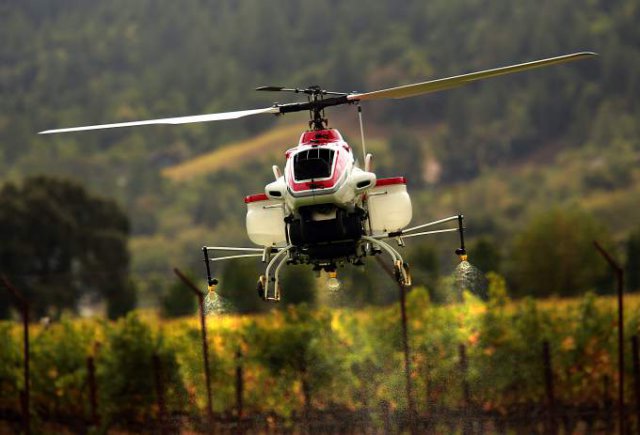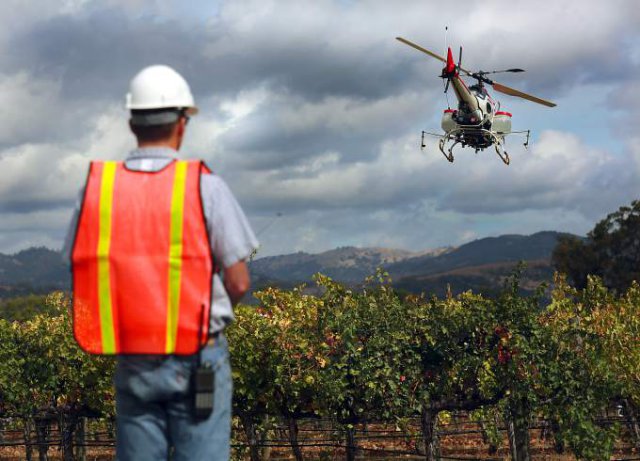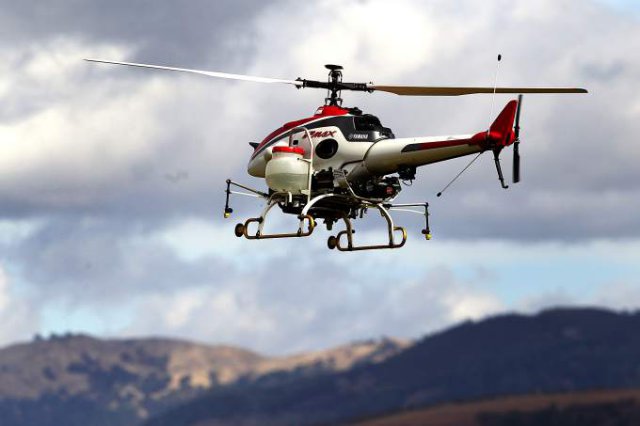As he went around Napa Valley in the past two years, Ken Giles had the unenviable task of notifying nearby residents that UC Davis would be conducting a demonstration project using UAS to spray pesticides at its vineyard in Oakville.
Giles, a professor in the university’s biological and agricultural engineering department, said he was prepared for questions, especially given the civil rights qualms over military and police use of drones.
“I would go out and say, ‘I’m here to talk on drones spraying pesticides.’ If I was spraying over GMO crops, then I would have been three for three (on paranoia),” Giles wryly noted, referencing concerns over genetically modified organisms.
But Giles said he has not experienced much uproar over the program with partner Yamaha Motor Corp. USA, which has used its RMAX helicopter to test the efficiency and safety of aerial spraying over the Oakville vineyard. “It seems to be quieted down a bit,” he said.
The drones are expected to be more commonplace in the Napa vineyard, likely by next year if the Federal Aviation Administration approves Yamaha’s application to use unmanned aircraft systems for agricultural purposes.
Such approval appears increasingly likely as the FAA on Sept. 25 authorized six aerial photo and video production companies to use drones in the film and television industry.
“We feel the timing is right to investigate the U.S. market. We have been doing it the last couple years,” said Steve Markofski, business planner for Yamaha. “We have been focusing on high-value crops, specifically grapes here in Napa.”
Yamaha and UC Davis conducted a demonstration of the RMAX helicopter on Wednesday in conjunction with the Association for Unmanned Vehicle Systems International, a trade group which supports the defense, civil and commercial sectors. The aircraft, a small helicopter that weighs 140 pounds, carried water in its 2.1-gallon tanks, instead of pesticide.
Officials at the event were on message to continually utter the phrase “unmanned aircraft” as opposed to drones, which carry a more sinister meaning.
So far, the opposition to commercial use of drones is not as intense as that for military and police use.
“Our primary and basically exclusive focus has been and will continue to be on the use of drones by law enforcement,” said Will Matthews, senior communications officer for the ACLU of Northern California, via email.
Japan pioneered the use of drones in agriculture during the early 1990s, and now unmanned aircraft farm up to 40 percent of that country’s rice crop. Australia also uses drones for agricultural purposes.
Yamaha’s pitch for the American market is simple: the unmanned aircraft can save money, time and be more efficient than the traditional method of spraying by either tractor or by hand.
For example, the RMAX, flying approximately three meters above the vines at a speed up to 20 kilometers per hour, can cover up to 12 acres an hour. In contrast, a tractor can cover one acre. “We’re quite a bit faster compared to the current method,” Markofski said.
If approved, Yahama would likely target hilly vineyards, such as those along the Mayacmas Mountains, where spraying is much more difficult and time consuming. It also would apply for use in Yamhill County, Ore., which also has many wineries.
“Can you imagine treating those (hilly vineyards) with a ground tractor, how narrow those (fields) are and how risky that can be?” Markofski said.
The drones also can apply fertilizer and seeds as well as monitor crops. Yamaha would lease the aircraft, operated by a three-man team. The operator must remain up to 150 meters near the drone.
Yamaha is still formulating the price of the drones, pending approval, Markofski said.
UC Davis continues to crunch data from the test flights to monitor the drones’ efficiency, productivity and spray drift, Giles said. But so far there have been no red flags, especially in its safety.
“It’s a vehicle with potential where we know there are things we can do with it that we couldn’t do in the past — spot treatments, quick treatments, delivery of a very localized payload,” Giles said.
Source: The Press Democrat



